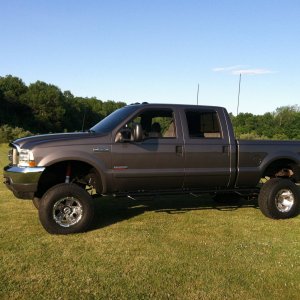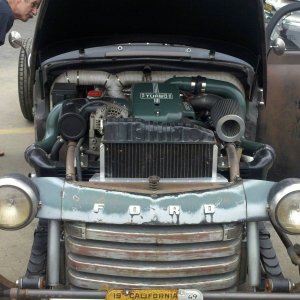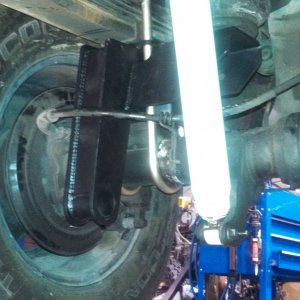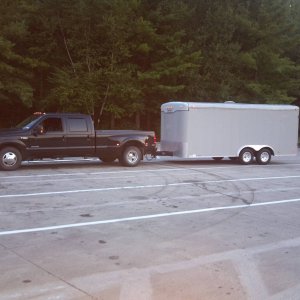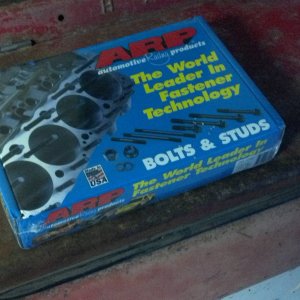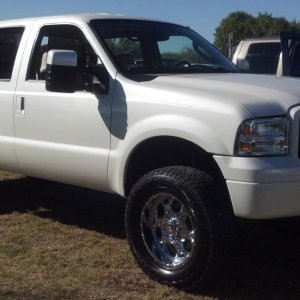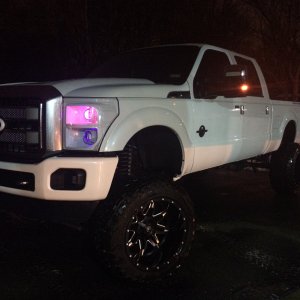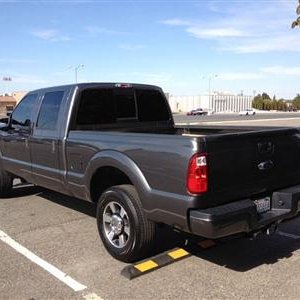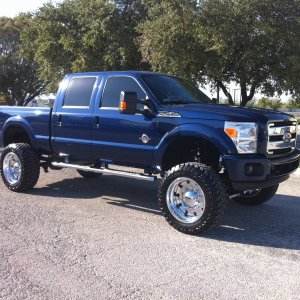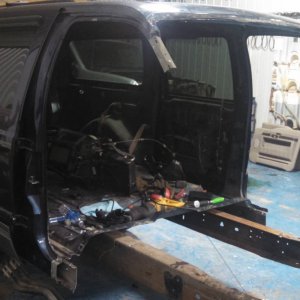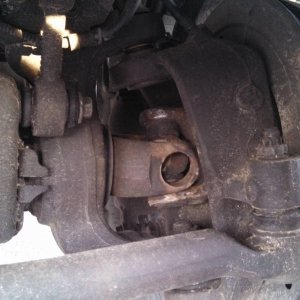You are using an out of date browser. It may not display this or other websites correctly.
You should upgrade or use an alternative browser.
You should upgrade or use an alternative browser.
FFD Rail System
- Thread starter njjeep
- Start date
Zeb
New member
That looks interesting.
In for details.
In for details.
Swaan
New member
- Joined
- Mar 19, 2012
- Messages
- 734
- Reaction score
- 0
What a crock of ****. It's all about volume people. How is this gimic going to increase volume of oil to feed big hungry injectors. The only thing that's going to cure that is a bigger pump plain and simple.
Sure your pressures will be up only because now you have a big ass restriction in the oil log,(manifold). The only thing that will be happy is your ecm because it wont throw a code because the pressure is now fine. But your injectors are still running short . Simple band aid fix for a CEL . Nothing more.
Everyone knows you cant compress a liquid so how can making the oil log smaller increase presure??
Once the log is full of oil it wont make any diffrence. Wow.
Sure your pressures will be up only because now you have a big ass restriction in the oil log,(manifold). The only thing that will be happy is your ecm because it wont throw a code because the pressure is now fine. But your injectors are still running short . Simple band aid fix for a CEL . Nothing more.
Everyone knows you cant compress a liquid so how can making the oil log smaller increase presure??
Once the log is full of oil it wont make any diffrence. Wow.
Last edited:
Zeb
New member
What a crock of ****. It's all about volume people. How is this gimic going to increase volume of oil to feed big hungry injectors. The only thing that's going to cure that is a bigger pump plain and simple.
Sure your pressures will be up only because now you have a big restriction in the oil log,(manifold). The only thing that will be happy is your ecm because it wont throw a code because the pressure is now fine. But your injectors are still running short . Simple band aid fix for a CEL . Nothing more.
Everyone knows you cant compress a liquid so how can making the oil log smaller increase presure??
Once the log is full of oil it wont make any diffrence. Wow.
My thoughts exactly.
I can’t see how making the rail volume smaller is going to help anything. I’d like to hear from someone who has tried it.
Last edited:
dsberman94
Well-known member
Because it tricks the simpletons. The gauge reads higher but the volume of oil just isn’t there.
Swaan
New member
- Joined
- Mar 19, 2012
- Messages
- 734
- Reaction score
- 0
Yup..... basic fluid dynamics. Big ass oil hungry injectors need a bigger displacment pump to keep up with demand.
No smaller oil rail is going to magically supply more oil.
No smaller oil rail is going to magically supply more oil.
I’m not gonna jump on here a start a fight over the product. But what I will do is back it up. Think about how we came up with this problem to begin with. The stock pump could keep up with stock injectors. We enlarged the injectors by taking material away from the HPO system in the form machine the intensifier piston. So we had to add more oil to the system by way of a modified pump or a dual pump setup. But we kept over thinking the problem. So the thought of adding material back to the system came about. But not adding it to the injector area, but up stream in the oil log area. Essentially, we took a fire hose that had been hooked up to the house for so long and attached a regular garden hose. When we slipped the rails in to the motor, all of a sudden, our pressure came back. We didn’t have to rely on the pump to maintain that huge chamber. We allowed that rail system to take up some area. When it did that, it allowed the pump to not work as hard, and still maintain proper pressure to the system. The ICP went up and the IPR dirt cycle went down. It allowed less work out of the pump and was able to dump more oil out of the system than it needed to use.
If you’ve seen the drag truck running any this year, it’s been running a set of 400/300’s on these rails and an Adrenaline. No tricks. No gimmicks. No special DieselSite pump or an overdrive unit or anything. The truck has been running in the 6’s consistently.
We wouldn’t put a product to market like this if we were trying to pull a fast one on people. It’s not a gimmick. Our company has been in the industry too long to do that to people. Our reputation with our customers, and the dealers we work with, come first. We know we will have naysayers, but once we get all of the data out there, we hope to surprise a lot of people, help customers run bigger injectors and to make more power than before because they couldn’t afford to run a twin pump setup.
I’m open for questions on it, but don’t know how much I’ll be able to answer not being a sponsor.
If you’ve seen the drag truck running any this year, it’s been running a set of 400/300’s on these rails and an Adrenaline. No tricks. No gimmicks. No special DieselSite pump or an overdrive unit or anything. The truck has been running in the 6’s consistently.
We wouldn’t put a product to market like this if we were trying to pull a fast one on people. It’s not a gimmick. Our company has been in the industry too long to do that to people. Our reputation with our customers, and the dealers we work with, come first. We know we will have naysayers, but once we get all of the data out there, we hope to surprise a lot of people, help customers run bigger injectors and to make more power than before because they couldn’t afford to run a twin pump setup.
I’m open for questions on it, but don’t know how much I’ll be able to answer not being a sponsor.
lincolnlocker
Well-known member
Things that make you go, hmmmm.
live life full throttle
live life full throttle
Swaan
New member
- Joined
- Mar 19, 2012
- Messages
- 734
- Reaction score
- 0
Sorry. Still not buying it.
Only reason your icp went up and duty cycle down is because the manifold cant supply the injectors the same amount of oil . A direct result of the restrictions in the log.
Your drag truck going 6s with those injectors speaks huge for the dieselsite adrenaline pump, nothing else. I guarentee you if you took those things out of the rails and put another pump on that truck your power will go up.
Once that log or manifold is full oil and no air it shouldn't matter how big it is . After all it's the injectors that "need" the oil . If there was a way to read the presure at the injector itself after the rail it would be telling you a whole different story.
Ever stop to think that the engineers at international designed the oil rail that big for a reason?
Only reason your icp went up and duty cycle down is because the manifold cant supply the injectors the same amount of oil . A direct result of the restrictions in the log.
Your drag truck going 6s with those injectors speaks huge for the dieselsite adrenaline pump, nothing else. I guarentee you if you took those things out of the rails and put another pump on that truck your power will go up.
Once that log or manifold is full oil and no air it shouldn't matter how big it is . After all it's the injectors that "need" the oil . If there was a way to read the presure at the injector itself after the rail it would be telling you a whole different story.
Ever stop to think that the engineers at international designed the oil rail that big for a reason?
Last edited:
blacksmoke.r.us
Member
If you know anything about fluid dynamics it make perfect sense.
The hpop lines that supply the stock oil rails are much smaller than the oil rail it self and still have enough area to supply volume for injectors requiring more volume.
So the smaller diameter hpop lines (pipe) feed the larger diamter oil rail (pipe) lossing pressure which in turn loses volume. If you keep the diamter of the oil rail closer to the diameter of the hpop lines you lose less pressure. So there would be no need for a larger pump to make up the difference.
To prove this all FFD would need to do is dyno the truck now with the new rails. Then pull the new rails and dyno again not changing anything else mechanically
On another note the only thing that this would affect is the availble volume of high pressure oil for the injectors. As long as the rails hold enough volume for the the given injector it should work. And it is cause the truck is running making good enough power to get in the 6's.
The hpop lines that supply the stock oil rails are much smaller than the oil rail it self and still have enough area to supply volume for injectors requiring more volume.
So the smaller diameter hpop lines (pipe) feed the larger diamter oil rail (pipe) lossing pressure which in turn loses volume. If you keep the diamter of the oil rail closer to the diameter of the hpop lines you lose less pressure. So there would be no need for a larger pump to make up the difference.
To prove this all FFD would need to do is dyno the truck now with the new rails. Then pull the new rails and dyno again not changing anything else mechanically
On another note the only thing that this would affect is the availble volume of high pressure oil for the injectors. As long as the rails hold enough volume for the the given injector it should work. And it is cause the truck is running making good enough power to get in the 6's.
Last edited:
Sorry. Still not buying it.
Only reason your icp went up and duty cycle down is because the manifold cant supply the injectors the same amount of oil . A direct result of the restrictions in the log.
Your drag truck going 6s with those injectors speaks huge for the dieselsite adrenaline pump, nothing else. I guarentee you if you took those things out of the rails and put another pump on that truck your power will go up.
Once that log or manifold is full oil and no air it shouldn't matter how big it is . After all it's the injectors that "need" the oil . If there was a way to read the presure at the injector itself after the rail it would be telling you a whole different story.
Ever stop to think that the engineers at international designed the oil rail that big for a reason?
Swaan,
Why do you think pressures went down in these systems when we made bigger injectors? More volume in the WHOLE system. (WHOLE System includes: injector piston area, feed hole in the injector, oil feed passage from the oil log to the injector, oil log itself, HPOP lines and the pump itself.) The bigger the area ,as a WHOLE to fill up, requires more oil that the HPOP has to produce. If we lessen the area of the WHOLE system, we are lessening the amount of oil being used. Lessen the oil used, the pressure goes up.
It's back tracking through the system to fix a problem that came up when the larger injectors were developed. We made caused a problem when we made them too big. First thing that was thought of was, 'We took material away and created more oil volume. We need to add more oil." That's not the case any more. By adding the "material back" that we took away from when we machined the injectors, plus a lot more, the objective of raising the oil pressure in the WHOLE system was achieved.
If you don't want to believe it, that's fine. We know that what we are selling is going to be a great product that will give people an alternative to what has been pushed on them in the past for years that, "you need more!!" We will prove that it is rather the opposite, that in the end, less is more.
If you know anything about fluid dynamics it make perfect sense.
The hpop lines that supply the stock oil rails are much smaller than the oil rail it self and still have enough area to supply volume for injectors requiring more volume.
So the smaller diameter hpop lines (pipe) feed the larger diamter oil rail (pipe) lossing pressure which in turn loses volume. If you keep the diamter of the oil rail closer to the diameter of the hpop lines you lose less pressure. So there would be no need for a larger pump to make up the difference.
To prove this all FFD would need to do is dyno the truck now with the new rails. Then pull the new rails and dyno again not changing anything else mechanically
On another note the only thing that this would affect is the availble volume of high pressure oil for the injectors. As long as the rails hold enough volume for the the given injector it should work. And it is cause the truck is running making good enough power to get in the 6's.
So in our research for the patent, we came across a different design of the head itself. Basically the same design, but with no OIL LOG. 8 lines running in to the injector feed lines in the head. This was not cost effective method for International, so this is when they came up with the oil log method on the head. And if you think about it, the first "Common Rail" system, only using oil and not fuel.
lincolnlocker
Well-known member
Not cost effective but could you imagine the possibility of smaller oil lines feeding each individual injector instead of a hallowed out tube that requires more volume. Id say someone needs to get a set of those heads. Lol. Or make new ones.So in our research for the patent, we came across a different design of the head itself. Basically the same design, but with no OIL LOG. 8 lines running in to the injector feed lines in the head. This was not cost effective method for International, so this is when they came up with the oil log method on the head. And if you think about it, the first "Common Rail" system, only using oil and not fuel.
Your rail plugs make perfect sense.
Swaan needs to think about hydraulics and sizes of lines. Hell, even a garden hose diameter vs a fire hose hooked to the same water nozzle..
live life full throttle
The general equation describing fluid dynamics of this nature is the Hagen-Poiseuille (HP) equation:
dP = 8uLQ/(pi * R^4)
where dP is the pressure difference over the length of the system L, u is the dynamic viscosity (intrinsic to the oil), Q is the volumetric flow rate, and R is the pipe radius.
All injectors require sufficient volume (Q) and pressure (P) of oil to operate. Generally, larger injectors require more volume (Q) than smaller injectors. As can be seen by the HP equation, providing more volume (Q) to the injectors requires EITHER larger dP, smaller L, or larger R.
The pump provides the dP, which drives the volumetric rate (Q), and in practice is the single easiest way to provide more volume of oil, which is why many people opt for aftermarket HPOPs.
While the pump is the easiest thing to replace, the most EFFECTIVE way to increase volumetric flow rate (Q) at a constant supplied pressure (dP) is to INCREASE the radius (R) of the pipes supplying the oil. See that in the HP equation the radius (R) is raised to the 4th power! Small differences here will net drastic differences in the flow characteristics.
In the 7.3l oil supply system the oil log actually represents a larger radius pipe supplying oil to the injectors. In this region of the system the oil will flow the most efficiently and require the least pressure (dP) to move the same amount of volume (Q). Reducing the radius here will not help provide more oil to the injectors, it will further restrict the system.
Reducing that volume will speed up the time it takes to FILL the log with oil, ie. after a complete oil change, but will not provide more oil to the injectors given that the system is already full.
Going with the garden hose and fire hose analogy the question isn't about the volume of the hoses (oil log) but the restriction at the end (injectors). If both hoses have the same size nozzle restriction the larger hose will supply more volume. The only difference will be the time for them both to reach steady state, ie. fill up the hose.
dP = 8uLQ/(pi * R^4)
where dP is the pressure difference over the length of the system L, u is the dynamic viscosity (intrinsic to the oil), Q is the volumetric flow rate, and R is the pipe radius.
All injectors require sufficient volume (Q) and pressure (P) of oil to operate. Generally, larger injectors require more volume (Q) than smaller injectors. As can be seen by the HP equation, providing more volume (Q) to the injectors requires EITHER larger dP, smaller L, or larger R.
The pump provides the dP, which drives the volumetric rate (Q), and in practice is the single easiest way to provide more volume of oil, which is why many people opt for aftermarket HPOPs.
While the pump is the easiest thing to replace, the most EFFECTIVE way to increase volumetric flow rate (Q) at a constant supplied pressure (dP) is to INCREASE the radius (R) of the pipes supplying the oil. See that in the HP equation the radius (R) is raised to the 4th power! Small differences here will net drastic differences in the flow characteristics.
In the 7.3l oil supply system the oil log actually represents a larger radius pipe supplying oil to the injectors. In this region of the system the oil will flow the most efficiently and require the least pressure (dP) to move the same amount of volume (Q). Reducing the radius here will not help provide more oil to the injectors, it will further restrict the system.
Reducing that volume will speed up the time it takes to FILL the log with oil, ie. after a complete oil change, but will not provide more oil to the injectors given that the system is already full.
Going with the garden hose and fire hose analogy the question isn't about the volume of the hoses (oil log) but the restriction at the end (injectors). If both hoses have the same size nozzle restriction the larger hose will supply more volume. The only difference will be the time for them both to reach steady state, ie. fill up the hose.
Swaan
New member
- Joined
- Mar 19, 2012
- Messages
- 734
- Reaction score
- 0
All your points would hold merit if we are talking air. But no we are talking fluid. You cant compress a fluid. Therefore if the rail is 100% full of oil and no air then it doesn't matter how big the log is 500ml or 5 gallon. What goes out must come in. It isn't the log consuming the oil it is the bigger intensfier piston and longer stroke of the injectors. Nothing more. They are what is demanding more volume. Again nothing more. Your kidding yourself if you think otherwise.
Those logs were designed like that to make sure every injector gets a balanced pressure of high pressure oil . It makes for a smooth running engine and ensures that they are getting fed equally. Thing irrigation system. 50 sprinklers on a 100' 4" pipe. The sprinkler at the end would be getting half the volume if you make the pipe 2" now wouldn't it.!!!!! Oh but hey look! Our pressure is up!!!! .
If your theroy held any water at all why do you think the common rail guys put bigger CP pumps on. You dont see them going down in line size now do you.. holy hell people.
Look up bernoullis principal on fluid dynamics. My head is sore.
Those logs were designed like that to make sure every injector gets a balanced pressure of high pressure oil . It makes for a smooth running engine and ensures that they are getting fed equally. Thing irrigation system. 50 sprinklers on a 100' 4" pipe. The sprinkler at the end would be getting half the volume if you make the pipe 2" now wouldn't it.!!!!! Oh but hey look! Our pressure is up!!!! .
If your theroy held any water at all why do you think the common rail guys put bigger CP pumps on. You dont see them going down in line size now do you.. holy hell people.
Look up bernoullis principal on fluid dynamics. My head is sore.
Swaan
New member
- Joined
- Mar 19, 2012
- Messages
- 734
- Reaction score
- 0
The general equation describing fluid dynamics of this nature is the Hagen-Poiseuille (HP) equation:
dP = 8uLQ/(pi * R^4)
where dP is the pressure difference over the length of the system L, u is the dynamic viscosity (intrinsic to the oil), Q is the volumetric flow rate, and R is the pipe radius.
All injectors require sufficient volume (Q) and pressure (P) of oil to operate. Generally, larger injectors require more volume (Q) than smaller injectors. As can be seen by the HP equation, providing more volume (Q) to the injectors requires EITHER larger dP, smaller L, or larger R.
The pump provides the dP, which drives the volumetric rate (Q), and in practice is the single easiest way to provide more volume of oil, which is why many people opt for aftermarket HPOPs.
While the pump is the easiest thing to replace, the most EFFECTIVE way to increase volumetric flow rate (Q) at a constant supplied pressure (dP) is to INCREASE the radius (R) of the pipes supplying the oil. See that in the HP equation the radius (R) is raised to the 4th power! Small differences here will net drastic differences in the flow characteristics.
In the 7.3l oil supply system the oil log actually represents a larger radius pipe supplying oil to the injectors. In this region of the system the oil will flow the most efficiently and require the least pressure (dP) to move the same amount of volume (Q). Reducing the radius here will not help provide more oil to the injectors, it will further restrict the system.
Reducing that volume will speed up the time it takes to FILL the log with oil, ie. after a complete oil change, but will not provide more oil to the injectors given that the system is already full.
Going with the garden hose and fire hose analogy the question isn't about the volume of the hoses (oil log) but the restriction at the end (injectors). If both hoses have the same size nozzle restriction the larger hose will supply more volume. The only difference will be the time for them both to reach steady state, ie. fill up the hose.
Thank you for explaining it in a way I couldn't. Maybe now they will understand
Swaan
New member
- Joined
- Mar 19, 2012
- Messages
- 734
- Reaction score
- 0
Going further with the fire hose analogy, the reason the firemen use a hose larger than a garden hose is specifically because it will provide more volume of water.
Yes exaclly. But hey the pressure at the fire truck is great with that garden hose right!!!!!! But why is the house still burning?????
lincolnlocker
Well-known member
So you think that theres no pressure drop in the oil rail?Going further with the fire hose analogy, the reason the firemen use a hose larger than a garden hose is specifically because it will provide more volume of water.
Just like theres no pressure drop in the fuel rail with huge injectors i suppose?
live life full throttle

